#Java Basics Guide
Text
How to Think Like a Programmer: Understanding Data Structures
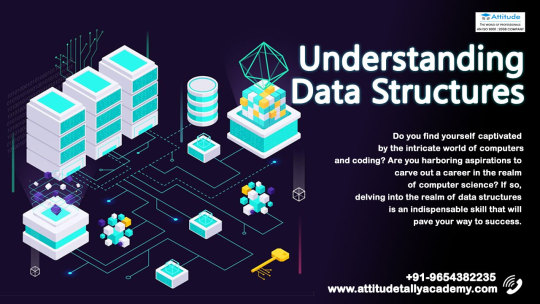
Introduction:
Are you fascinated by the world of computers and coding? Do you aspire to build a career in computer science? If so, understanding data structures fundamentals is an essential skill that will set you on the right path. In this blog, we'll explore what data structures are, why they're crucial for aspiring programmers, and how you can start thinking like a programmer by mastering them.
1. What are Data Structures?
Data structures are a way of organizing and storing data in a computer so that it can be used efficiently.
Think of data structures as containers that hold data in a structured manner, making it easier to access, manipulate, and process.
2. Why is Data Structures Important?
Data structures form the foundation of structured programming principles.
They help optimize algorithms and improve the efficiency of software applications.
Understanding data structures is crucial for solving complex problems and writing efficient code.
3. Data Structure Fundamentals
Arrays: An ordered collection of elements accessed using an index.
Linked Lists: A linear collection of elements where each element points to the next.
Stacks: A Last In, First out (LIFO) data structure where elements are added and removed from the same end.
Queues: A First In, First out (FIFO) data structure where elements are added at one end and removed from the other.
4. Structured Programming Principles
Modularity: Breaking down a program into smaller, manageable modules or functions.
Abstraction: Hiding the complexity of implementation details and exposing only essential features.
Encapsulation: Bundling data and methods that operate on that data into a single unit, known as a class.
Reusability: Writing code in a way that it can be reused in different parts of the program or in other programs.
5. How to Think Like a Programmer
Start by understanding the problem thoroughly before diving into coding.
Choose the right data structure based on the problem requirements.
Analyze the time and space complexity of algorithms to ensure efficiency.
Practice problem-solving regularly to sharpen your skills and intuition.
By mastering data structures and data structured programming principles, you'll not only become a better programmer but also open doors to exciting career opportunities in computer science. Whether you're pursuing a course, looking for an institute, or seeking training centers, remember that a solid understanding of data structures will be your key to success.
In conclusion, thinking like a programmer involves more than just writing code – it's about understanding the underlying principles that drive efficient and elegant solutions. So, embrace the world of data structures, and embark on your journey to becoming a skilled programmer!
Suggested Blogs:
Java Basics Guide
Python basics to advanced
Java Programming
#Python basics to advanced#Java Basics Guide#data structured programming#data structures fundamentals#data structure
0 notes
Text
The Basics of Java Programming: A Beginner's Guide
Java is one of the most popular programming languages used for building a variety of applications such as web applications, mobile applications, desktop applications, and more.
0 notes
Text




( 🫧 ) - SERENADE : GIF PAGE THEME (2 Ver. - Java FREE) !
FEATURES . . ( TYPE 1 )
4 links
Content filter
Faceclaim details
No. of Gif completed
FEATURES . . ( TYPE 2 )
4 links
No. of Gif completed
Description box (to put rules, more infos, etc)
Member section/other featured packs.
Status Bar (Animated, can be edited based on the completion)
OTHERS . .
No JavaScript involved in the codes, so this can be use with ease.
Photo sizes is stated in the code once installed.
This theme is inspired by many which you can view here.
Special thanks to Julie ς꒰ ˊ˘ ˁ ⑅ ꒱ა for helpin' me look at the codes & layout.
GUIDES . .
Read RULES here, and other basic rules apply as well when usin' the theme. Please, be respectful and DO NOT steal/copy/repost any parts of my resources or remove the credit or use it as a base code. DO NOT share the codes with others once you purchase it, it's for you and you only. If you use my resources, REBLOG the post. Consider supportin' me in ko-fi too if you feel like it. If there's any inquiries, feel free to leave them in my inbox. Thank you & have a nice day!
Find related links: Previews (V1, V2). Codes (V1, V2).
This is a FREE THEME.
148 notes
·
View notes
Text
LMK OC COMPETITION - ROUND 1


click to see full image
Ox-Head belongs to @allthenicknamesweretaken
Java belongs to @the-real-dev
Learn more about them below the cut!!
Ox-Head:
Ox-head is one of the many servants of the Underworld. He exists in a world where ox-heads and horse-faces are a species, guarding the Underworld and guiding the many many souls to their inevitable destination there. These servants don no name as there is no use for one, the only thing that matters is their job. This ox-head, however, has been doubting their leaders' motives and whether they really are worth following. No matter. It can't be more important than their job... Can it?
Java:
Spider demon OC! He's Syntax's cousin and childhood friend. He's basically the inventor of the spider gang (since Syntax is the coder!)
He also has a set of spider legs, but he actually uses them as arms. Think Garmadon from Ninjago. Fun Fact: I named him after Minecraft: Java edition, as well as Java the actual coding language (to parallel with Syntax :3)
#ox-head#java#round 1#oc polls#lmk#monkie kid#lego monkie kid#lmk oc#lego monkie kid oc#lmk oc competition
19 notes
·
View notes
Text
Tl;Dr - Primbon is like a type of "Zodiac System" for the Javanese where we use nature, astrology etc as a tool for divination, cleansing, etc.
----
I want to ramble a little about Indonesia's old spirituality, mythicisms and beliefs!!
I'm not entirely religious but ever since I practice Tarot, I have this belief of souls and spirit guardians in divination, and the more I practice divination the more I feel rooted into our culture's old beliefs.
Anyway, this has nothing to do with that... kinda.
Here in Java, we have this old manuscript called Primbon Palintangan Palindon Pakedutan, it contained texts on physiognomy and astrology, as well as other subjects.

In this age, to believe in Primbon can be seen as Syirik and could lead to blasphemy.
According to KBBI, Primbon is defined as a Book consisting of forecast, knowledge of kejawen, occultism, a peculiar numeric system for calculating lucky days, prayers, selections from the Qur’an, instructions relating to ritual purity and performance of obligatory worship, texts on mysticism, astronomy, astrology, and every other important matter.
This book is mainly oriented towards the relationship between mankind and nature and is used as a life guide for Javanese people. Jogja also have their own Primbon called Bataljemur Adammakna!

Primbon uses the Javanese calendar where every day, month, and year has its own calculation and is used to identify events that could occur in the future. It could be used as divination and a tool to hone vigilance.
There are eleven teachings;
Pranata reads the universe and petungan are the numbers that reads your fate
Pawukon calculates time and dates
Perobatan, where medicinal Primbon filled with prayers, spells and spiritual intentions are inscribed into a piece of paper and then burnt. Its ashes can then be rubbed on an affected area to heal.
Wirid are messages, suggestions, or prohibitions that are considered necessary to be followed for the sake of creating harmony
Aji-aji reflects the supernatural side of Javanese life. It is believed that extraordinary supernatural powers are contained in a spell if it is truly believed.
Kidung is a song and / or poetry that contains advice and such.
Ramalan means Divination, it is self explanatory...
Kawilujengan contains guidelines about the implementation of Javanese rituals for various purposes.
Donga is similar to Aji-aji but uses the verses from the Quran and spelled in Javanese
Finally, Ngalamat or sasmita is usually a strange phenomenon in the universe that is considered an oddity. The phenomenon is then interpreted as a sign of something.
Basically, Primbon is like zodiac systems and common astrology for us!!! Also the Brits took six volumes in 1812!!!!!! Give it back along with our legendary Keris!!!!!!! Please :(
27 notes
·
View notes
Text
The Roadmap to Full Stack Developer Proficiency: A Comprehensive Guide
Embarking on the journey to becoming a full stack developer is an exhilarating endeavor filled with growth and challenges. Whether you're taking your first steps or seeking to elevate your skills, understanding the path ahead is crucial. In this detailed roadmap, we'll outline the stages of mastering full stack development, exploring essential milestones, competencies, and strategies to guide you through this enriching career journey.

Beginning the Journey: Novice Phase (0-6 Months)
As a novice, you're entering the realm of programming with a fresh perspective and eagerness to learn. This initial phase sets the groundwork for your progression as a full stack developer.
Grasping Programming Fundamentals:
Your journey commences with grasping the foundational elements of programming languages like HTML, CSS, and JavaScript. These are the cornerstone of web development and are essential for crafting dynamic and interactive web applications.
Familiarizing with Basic Data Structures and Algorithms:
To develop proficiency in programming, understanding fundamental data structures such as arrays, objects, and linked lists, along with algorithms like sorting and searching, is imperative. These concepts form the backbone of problem-solving in software development.
Exploring Essential Web Development Concepts:
During this phase, you'll delve into crucial web development concepts like client-server architecture, HTTP protocol, and the Document Object Model (DOM). Acquiring insights into the underlying mechanisms of web applications lays a strong foundation for tackling more intricate projects.
Advancing Forward: Intermediate Stage (6 Months - 2 Years)
As you progress beyond the basics, you'll transition into the intermediate stage, where you'll deepen your understanding and skills across various facets of full stack development.
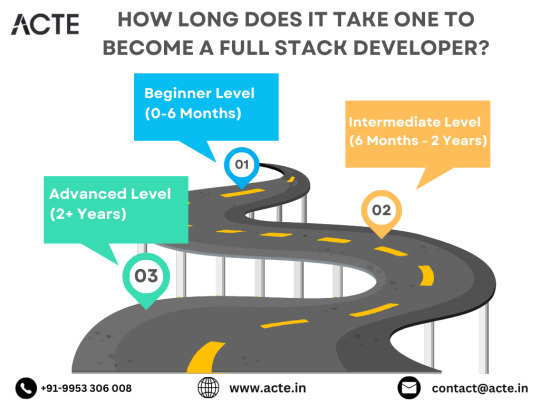
Venturing into Backend Development:
In the intermediate stage, you'll venture into backend development, honing your proficiency in server-side languages like Node.js, Python, or Java. Here, you'll learn to construct robust server-side applications, manage data storage and retrieval, and implement authentication and authorization mechanisms.
Mastering Database Management:
A pivotal aspect of backend development is comprehending databases. You'll delve into relational databases like MySQL and PostgreSQL, as well as NoSQL databases like MongoDB. Proficiency in database management systems and design principles enables the creation of scalable and efficient applications.
Exploring Frontend Frameworks and Libraries:
In addition to backend development, you'll deepen your expertise in frontend technologies. You'll explore prominent frameworks and libraries such as React, Angular, or Vue.js, streamlining the creation of interactive and responsive user interfaces.
Learning Version Control with Git:
Version control is indispensable for collaborative software development. During this phase, you'll familiarize yourself with Git, a distributed version control system, to manage your codebase, track changes, and collaborate effectively with fellow developers.
Achieving Mastery: Advanced Phase (2+ Years)
As you ascend in your journey, you'll enter the advanced phase of full stack development, where you'll refine your skills, tackle intricate challenges, and delve into specialized domains of interest.
Designing Scalable Systems:
In the advanced stage, focus shifts to designing scalable systems capable of managing substantial volumes of traffic and data. You'll explore design patterns, scalability methodologies, and cloud computing platforms like AWS, Azure, or Google Cloud.
Embracing DevOps Practices:
DevOps practices play a pivotal role in contemporary software development. You'll delve into continuous integration and continuous deployment (CI/CD) pipelines, infrastructure as code (IaC), and containerization technologies such as Docker and Kubernetes.
Specializing in Niche Areas:
With experience, you may opt to specialize in specific domains of full stack development, whether it's frontend or backend development, mobile app development, or DevOps. Specialization enables you to deepen your expertise and pursue career avenues aligned with your passions and strengths.
Conclusion:
Becoming a proficient full stack developer is a transformative journey that demands dedication, resilience, and perpetual learning. By following the roadmap outlined in this guide and maintaining a curious and adaptable mindset, you'll navigate the complexities and opportunities inherent in the realm of full stack development. Remember, mastery isn't merely about acquiring technical skills but also about fostering collaboration, embracing innovation, and contributing meaningfully to the ever-evolving landscape of technology.
#full stack developer#education#information#full stack web development#front end development#frameworks#web development#backend#full stack developer course#technology
7 notes
·
View notes
Text
Playing Minecraft with an AI Alastor
Title says it all, pretty much. I am letting an AI Alastor "play" Minecraft. Basically, I just give him actions to choose, and he picks what to do. He has the world on a random seed in hard mode. The world's name is "Carnage," and he even chose what Curseforge performance focused modpack the world is using. (Outside of mods meant to help boost performance so I can actually play Minecraft Java, the game is vanilla and the gameplay itself isn't altered.)
Alastor has three goals that he generated himself. He will be able to choose to stop or come up with new goals once all three are complete. The goals are as follows:
Eat rotten flesh (completed)
Trade with a villager (completed)
Enter and explore the Nether (In progress, I'm having him procrastinate from this because I'm scared of hostile mobs)
His current project is clearing the immediate areas of his base and the nearby village of trees so hostile mobs can't hide from the sun under them and cause trouble for both him and the villagers. His base is in a taiga forest, so...this project is taking a while.
Now ON TO THE TOUR!

This is Alastor's beloved shack. A patrol of pillagers raided it as soon as it was complete. Alastor defeated the patrol over the course of 2-3 deaths, and he hung the banner to intimidate any pillagers who dare pass by.

This is the storage house. It is a two-floor 5x5 (yes, the bot specified this) complex that holds storage.

This is his sugar cane farm. Alastor wanted this planted so he could have paper to trade to the local cartographer.

The unnamed sheep that Alastor wanted to keep for some reason.

The bridge that was built because the village and the ruined nether portal are both on the other side of the river.


Two perspectives of the road that connects the base and the village.
Obviously, the builds featured in the tour are human-made. All Alastor is doing is guiding me on what to do based on options I give him. Alastor can't actually play the game himself, given that he's a chatbot. Feel free to give suggestions I can give to the bot.
Playing Minecraft this way has been a fun experience.
Have some bonus c.ai screenshots.




5 notes
·
View notes
Text
java full stack
A Java Full Stack Developer is proficient in both front-end and back-end development, using Java for server-side (backend) programming. Here's a comprehensive guide to becoming a Java Full Stack Developer:
1. Core Java
Fundamentals: Object-Oriented Programming, Data Types, Variables, Arrays, Operators, Control Statements.
Advanced Topics: Exception Handling, Collections Framework, Streams, Lambda Expressions, Multithreading.
2. Front-End Development
HTML: Structure of web pages, Semantic HTML.
CSS: Styling, Flexbox, Grid, Responsive Design.
JavaScript: ES6+, DOM Manipulation, Fetch API, Event Handling.
Frameworks/Libraries:
React: Components, State, Props, Hooks, Context API, Router.
Angular: Modules, Components, Services, Directives, Dependency Injection.
Vue.js: Directives, Components, Vue Router, Vuex for state management.
3. Back-End Development
Java Frameworks:
Spring: Core, Boot, MVC, Data JPA, Security, Rest.
Hibernate: ORM (Object-Relational Mapping) framework.
Building REST APIs: Using Spring Boot to build scalable and maintainable REST APIs.
4. Database Management
SQL Databases: MySQL, PostgreSQL (CRUD operations, Joins, Indexing).
NoSQL Databases: MongoDB (CRUD operations, Aggregation).
5. Version Control/Git
Basic Git commands: clone, pull, push, commit, branch, merge.
Platforms: GitHub, GitLab, Bitbucket.
6. Build Tools
Maven: Dependency management, Project building.
Gradle: Advanced build tool with Groovy-based DSL.
7. Testing
Unit Testing: JUnit, Mockito.
Integration Testing: Using Spring Test.
8. DevOps (Optional but beneficial)
Containerization: Docker (Creating, managing containers).
CI/CD: Jenkins, GitHub Actions.
Cloud Services: AWS, Azure (Basics of deployment).
9. Soft Skills
Problem-Solving: Algorithms and Data Structures.
Communication: Working in teams, Agile/Scrum methodologies.
Project Management: Basic understanding of managing projects and tasks.
Learning Path
Start with Core Java: Master the basics before moving to advanced concepts.
Learn Front-End Basics: HTML, CSS, JavaScript.
Move to Frameworks: Choose one front-end framework (React/Angular/Vue.js).
Back-End Development: Dive into Spring and Hibernate.
Database Knowledge: Learn both SQL and NoSQL databases.
Version Control: Get comfortable with Git.
Testing and DevOps: Understand the basics of testing and deployment.
Resources
Books:
Effective Java by Joshua Bloch.
Java: The Complete Reference by Herbert Schildt.
Head First Java by Kathy Sierra & Bert Bates.
Online Courses:
Coursera, Udemy, Pluralsight (Java, Spring, React/Angular/Vue.js).
FreeCodeCamp, Codecademy (HTML, CSS, JavaScript).
Documentation:
Official documentation for Java, Spring, React, Angular, and Vue.js.
Community and Practice
GitHub: Explore open-source projects.
Stack Overflow: Participate in discussions and problem-solving.
Coding Challenges: LeetCode, HackerRank, CodeWars for practice.
By mastering these areas, you'll be well-equipped to handle the diverse responsibilities of a Java Full Stack Developer.
visit https://www.izeoninnovative.com/izeon/
2 notes
·
View notes
Text
Mastering Java: Your Comprehensive Guide to Programming Excellence
Embarking on the journey of mastering Java is akin to entering a realm of endless possibilities. Java, a versatile and widely-utilized programming language, offers a broad spectrum of applications, from crafting web and mobile applications to powering robust enterprise systems. Whether you are a novice in the realm of coding or a seasoned programmer looking to broaden your skill set, the path to proficiency in Java is an exciting one.

In this comprehensive guide, we will be your guiding light through the intricacies of Java, starting from the foundational basics and progressing to the more advanced aspects of the language. Our objective is to equip you with the knowledge and skills that form a robust and unshakable foundation for your journey into the vibrant world of Java. Fasten your seatbelt as we embark on this exhilarating exploration, charting a course that will empower you to thrive in the ever-evolving landscape of software development.
Here's a 8-step guide to effectively learn Java
Step 1: Setting Up Your Development Environment
Your journey to becoming a proficient Java developer commences with setting up your development environment. The essential components are the Java Development Kit (JDK) and an Integrated Development Environment (IDE) like Eclipse or IntelliJ IDEA. These tools aren't just convenient; they're the gears that will drive your Java programming endeavors. They streamline the coding process, provide useful features, and offer an organized workspace, making your coding experience efficient and enjoyable.
Step 2: The Foundation - Learning the Basics
With your development environment ready, it's time to delve into the fundamental building blocks of Java. Begin by acquainting yourself with data types, variables, operators, and control structures. These are the nuts and bolts of the language, and a solid grasp of these concepts is essential. You'll find an abundance of online tutorials and beginner-friendly Java books to assist you at this stage.
Step 3: Navigating the World of Object-Oriented Programming (OOP)
The object-oriented programming (OOP) approach is well known in Java. To harness the true power of Java, immerse yourself in the world of OOP. Understand the concepts of classes, objects, inheritance, encapsulation, and polymorphism. This knowledge forms the bedrock of Java programming and enables you to design efficient, organized, and scalable code.
Step 4: Mastering Data Structures and Algorithms
Data structures (such as arrays, lists, and sets) and algorithms are the secret sauce behind solving real-world problems efficiently. As you progress, dive into the world of data structures and algorithms. These are the tools that will empower you to handle complex tasks and optimize your code. They're your go-to assets for creating efficient and responsive applications.
Step 5: The Art of Exception Handling
Java boasts a robust exception-handling mechanism. Understanding how to handle exceptions properly is not just an add-on skill; it's a vital aspect of writing reliable code. Exception handling ensures that your code gracefully manages unexpected situations, preventing crashes and delivering a seamless user experience.
Step 6: Exploring Input and Output Operations
In this step, you'll explore the realm of input and output (I/O) operations. Mastering I/O is crucial for reading and writing files, as well as interacting with users. You'll gain the ability to build applications that can efficiently process data and communicate effectively with users.
Step 7: Conquering Multi tasking
Java's support for multi tasking is a significant advantage. Understanding how to manage threads and synchronize their actions is vital for creating concurrent applications. Multithreading is the key to developing software that can handle multiple tasks simultaneously, making your applications responsive and scalable.
Step 8: Building Projects and Real-World Practice
Theory is only as valuable as its practical application. The final step involves applying what you've learned by building small projects. These projects serve as a proving ground for your skills and provide valuable additions to your portfolio. Whether it's a simple application or a more complex project, the act of building is where the real learning takes place.

As you step into this vibrant realm of Java, remember that continuous learning is the key to staying relevant and effective in the ever-evolving field of software development. Be open to exploring diverse applications, from web development to mobile apps and enterprise solutions, and never underestimate the power of hands-on practice. Building projects, no matter how small, will solidify your knowledge and boost your confidence.
In your quest to master Java, ACTE Technologies stands as a valuable ally. Their expert guidance and comprehensive training programs will sharpen your skills, boost your confidence, and pave the way for a rewarding career in software development. Whether you're embarking on your Java journey or looking to take your skills to the next level, ACTE Technologies offers the resources and support you need to thrive in the world of Java programming.
So, with Java as your trusty companion, and ACTE Technologies as your guide, the possibilities are boundless. Your journey is just beginning, and the world of software development awaits your innovation and expertise. Best of luck on your path to mastering Java!
9 notes
·
View notes
Text
Exploring Java's Built-in Data Structures: A Beginner's Guide
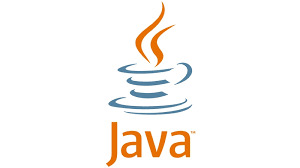
Introduction:
Java, a versatile and widely used programming language, offers a rich set of built-in data structures that form the backbone of many applications. Understanding these data structures is fundamental for any Java developer, as they provide efficient ways to organise and manipulate data. In this beginner's guide, we'll delve into some of Java's core data structures, exploring their features, usage, and best practices.
Arrays: The Foundation
Arrays are one of the simplest and most fundamental data structures in Java. They represent a fixed-size collection of elements of the same type. Declaring an array in Java is straightforward:
This line of code creates an array of integers with a length of 5. Arrays in Java are zero-indexed, meaning the first element is accessed at index 0, the second at index 1, and so on. You can access and modify elements using square brackets notation:
Arrays are efficient for random access but have a fixed size, which cannot be changed dynamically. Java provides other data structures like ArrayList and LinkedList to overcome this limitation. To kickstart your programming career, consider enrolling in Java Training In Chennai for comprehensive learning and skill development.
ArrayList: Dynamic Arrays
A component of Java's Collection Framework, ArrayList offers dynamic arrays that can enlarge or contract in size as needed. Unlike arrays, ArrayLists can hold elements of different types and automatically resize themselves.
ArrayLists offer efficient methods for adding, removing, and accessing elements. They also provide features like sorting and searching, making them versatile for various applications. However, ArrayLists may incur performance overhead due to resizing operations when they reach capacity.
LinkedList: Linked Data Structure
LinkedList is another data structure provided by Java's Collection Framework. In contrast to arrays, elements are stored in linked lists as nodes, each of which has a reference to the node after it in the sequence. Especially in the centre of the list, this structure makes insertion and deletion operations efficient.
LinkedLists excel in scenarios where frequent insertions and deletions are required, but they may have higher memory overhead than arrays due to the additional memory needed for storing references.
HashMap: Key-Value Pairs
HashMap is a data structure that stores key-value pairs and quickly retrieves values based on their keys. It uses a hashing technique to store and retrieve elements efficiently, making it ideal for scenarios where quick access to data is crucial.
HashMaps offer constant-time performance for basic operations like insertion, deletion, and lookup, assuming a good hash function and proper handling of collisions. However, they do not maintain the order of elements.
HashSet: Unordered Collection Of Unique Elements
HashSet implements the Set interface in Java, representing an unordered collection of unique elements. It uses a hashing technique similar to HashMap to achieve fast insertion, deletion, and lookup operations.
HashSet ensures that each element is unique by internally checking for duplicates before adding them. While HashSet does not maintain the insertion order, it provides constant-time performance for basic operations.
Stack And Queue: Linear Data Structures
Java also implements two essential linear data structures: Stack and Queue.
- The latest In, First Out (LIFO) concept is adhered to by Stack, meaning that the latest piece added is also the first to be withdrawn.
- The First In, First Out (FIFO) principle is adhered to by queues, meaning that the first element added is also the first to be deleted.
These data structures find applications in various scenarios, such as expression evaluation, reversing sequences, and managing tasks in computer algorithms.
Best Practices And Considerations
While Java's built-in data structures offer powerful capabilities, it's essential to understand their strengths, weaknesses, and best practices for efficient usage:
- Choose the right data structure based on your application's requirements. Consider factors like the frequency of insertion, deletion, retrieval operations, memory usage, and performance constraints.
- Understand the time complexity of operations for each data structure. For example, ArrayList provides faster random access but slower insertion and deletion than LinkedList.
- Be mindful of synchronisation if dealing with multi-threaded applications. Java provides synchronised versions of some data structures in the `java.util.concurrent` package.
- Utilise generics to ensure type safety and reduce the risk of runtime errors when working with collections.
-Consider using wrapper classes like `Collections.unmodifiableList()` or `Collections.synchronizedList()` for immutable or thread-safe collections, respectively.
- If you're looking for the Best Software Training Institute in Chennai, look no further than our renowned institution, where expertise meets excellence.
Conclusion
Java's built-in data structures form the backbone of many applications, providing efficient ways to organise, manipulate, and access data. From simple arrays to sophisticated HashMaps and LinkedLists, Java offers a versatile toolkit for developers to tackle various programming challenges. By understanding these data structures' features, usage, and best practices, beginners can lay a solid foundation for building robust and scalable Java applications. So, dive into Java's world of data structures and unlock the full potential of your programming endeavours.
#Java#softwaretraining#education#infycletechnologies#javascript#javatpoint#javaprogramming#java burn#javaris x
2 notes
·
View notes
Text
How to Learn Java Basics for Computer Programming
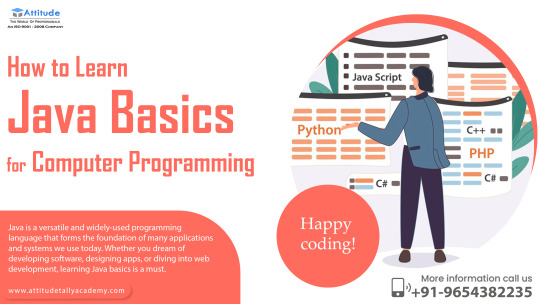
Introduction:
Are you captivated by the boundless world of computer science? Do you harbour aspirations of becoming a skilled programmer? If so, delving into the fundamentals of Java is an indispensable stride toward realizing your ambitions. Java stands as a versatile and extensively utilized programming language, forming the bedrock of myriad applications and systems we rely on today. Whether your aspirations lie in software development, app design, or web development, acquainting yourself with Core Java basics is an essential prerequisite.
Let's embark on a comprehensive journey into the realm of Java programming:
Unlocking the Significance of Java Basics:
Java serves as a gateway to deeper exploration within the realm of computer programming. A firm grasp of Java basics unfurls a plethora of career prospects in software development, web development, mobile app development, and beyond.
Enrolling in a Java Basics Course:
Scour for reputable institutions or training centers offering Java basics courses. Select a course that delves into fundamental concepts such as variables, data types, operators, control flow statements, and the principles of object-oriented programming.
Exploring Core Java Concepts:
Immerse yourself in pivotal concepts including classes, objects, inheritance, polymorphism, encapsulation, and abstraction. Master the art of creating and manipulating objects, defining classes, and implementing inheritance hierarchies.
Hands-On Practice:
Theory alone won't suffice; practice is the cornerstone of mastering Java basics. Regularly code to reinforce your comprehension of concepts. Experiment with bite-sized projects like calculator applications, simple games, or basic utilities to apply newfound knowledge effectively.
Harnessing Online Resources:
Embark on a voyage through online tutorials, forums, and communities dedicated to Java programming. Peruse official Java documentation and resources offered by Oracle for a comprehensive understanding.
Joining Coding Communities:
Engage with peers and seasoned developers in coding communities and forums. Participate in coding challenges, discussions, and collaborative projects to sharpen your skills and expand your knowledge base.
Staying Updated:
The landscape of technology evolves rapidly, and Java evolves in tandem. Stay abreast of the latest updates, trends, and best practices in Java programming. Follow reputable tech blogs, subscribe to newsletters, and partake in webinars or workshops to stay informed.
Seeking Guidance and Mentorship:
Don't shy away from seeking guidance from seasoned professionals or mentors in the field. Reach out to professors, senior students, or professionals entrenched in software development for invaluable advice and insights.
By diligently adhering to these steps, you'll establish a robust foundation in Java basics Guide, paving the path for a gratifying career in computer science. Remember, perseverance and practice are the linchpins of success in programming. Embrace challenges, glean wisdom from setbacks, and perpetually explore the expansive vistas of Java programming. Happy coding!
Suggested Blog:
C++ Development Trends
Java Programming
problem-solving strategies
#problem-solving strategies#Java Programming#C++ Development Trends#Java basics Guide#Core Java basics#computer science
0 notes
Text
From Beginner to Pro: Dominate Automated Testing with Our Selenium Course
Welcome to our comprehensive Selenium course designed to help individuals from all backgrounds, whether novice or experienced, enhance their automated testing skills and become proficient in Selenium. In this article, we will delve into the world of Selenium, an open-source automated testing framework that has revolutionized software testing. With our course, we aim to empower aspiring professionals with the knowledge and techniques necessary to excel in the field of automated testing.

Why Choose Selenium?
Selenium offers a wide array of features and capabilities that make it the go-to choice for automated testing in the IT industry.
It allows testers to write test scripts in multiple programming languages, including Java, Python, C#, and more, ensuring flexibility and compatibility with various project requirements.
Selenium’s compatibility with different web browsers such as Chrome, Firefox, Safari, and Internet Explorer makes it a versatile choice for testing web applications.
The ability to leverage Selenium WebDriver, which provides a simple and powerful API, allows for seamless interaction with web elements, making automating tasks easier than ever before.
Selenium’s Key Components:
Selenium IDE:
Selenium Integrated Development Environment (IDE) is a Firefox plugin primarily used for recording and playing back test cases. It offers a user-friendly interface, allowing even non-programmers to create basic tests effortlessly.
Although Selenium IDE is a valuable tool for beginners, our course primarily focuses on Selenium WebDriver due to its advanced capabilities and wider scope.
Selenium WebDriver:
Selenium WebDriver is the most critical component of the Selenium framework. It provides a programming interface to interact with web elements and perform actions programmatically.
WebDriver’s functionality extends beyond just browser automation; it also enables testers to handle alerts, pop-ups, frames, and handle various other web application interactions.
Our Selenium course places significant emphasis on WebDriver, equipping learners with the skills to automate complex test scenarios efficiently.
Selenium Grid:
Selenium Grid empowers testers by allowing them to execute tests on multiple machines and browsers simultaneously, making it an essential component for testing scalability and cross-browser compatibility.
Through our Selenium course, you’ll gain a deep understanding of Selenium Grid and learn how to harness its capabilities effectively.
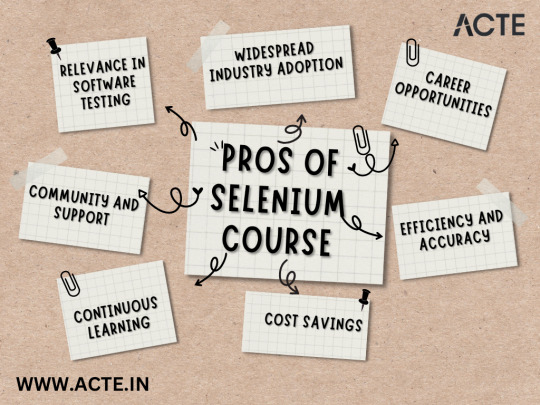
The Benefits of Our Selenium Course
Comprehensive Curriculum: Our course is designed to cover everything from the fundamentals of automated testing to advanced techniques in Selenium, ensuring learners receive a well-rounded education.
Hands-on Experience: Practical exercises and real-world examples are incorporated to provide learners with the opportunity to apply their knowledge in a realistic setting.
Expert Instruction: You’ll be guided by experienced instructors who have a profound understanding of Selenium and its application in the industry, ensuring you receive the best possible education.
Flexibility: Our course offers flexible learning options, allowing you to study at your own pace and convenience, ensuring a stress-free learning experience.
Industry Recognition: Completion of our Selenium course will provide you with a valuable certification recognized by employers worldwide, enhancing your career prospects within the IT industry.
Who Should Enroll?
Novice Testers: If you’re new to the world of automated testing and aspire to become proficient in Selenium, our course is designed specifically for you. We’ll lay a strong foundation and gradually guide you towards becoming a pro in Selenium automation.
Experienced Testers: Even if you already have experience in automated testing, our course will help you enhance your skills and keep up with the latest trends and best practices in Selenium.
IT Professionals: Individuals working in the IT industry, such as developers or quality assurance engineers, who want to broaden their skillset and optimize their testing processes, will greatly benefit from our Selenium course.
In conclusion, our Selenium course is a one-stop solution for individuals seeking to dominate automated testing and excel in their careers. With a comprehensive curriculum, hands-on experience, expert instruction, and industry recognition, you’ll be well-prepared to tackle any automated testing challenges that come your way. Make the smart choice and enroll in our Selenium course at ACTE Technologies today to unlock your full potential in the world of software testing.
7 notes
·
View notes
Text
Cloud's FNF GIF Making Tutorial
Hello there, have you ever wanted to make FNF GIFs like this for example?

Well, your in luck, because in my personal guide, I'll teach you how to do so.
This is for desktop users by the way, I don't know how to do this on mobile.
1. Getting Started
You'll need the following program to make your GIFs. I personally use.
Spr2PNG (Highly Recommended | Automated, Simple Process)
Java (Needed for Spr2PNG to work.)
EZGif (Needed for GIF Making.)
But there are other options such as FnF-Spritesheet-and-XML-Maker but I personally use Spr2PNG as that is more simple.
To download Spr2PNG, first go to the releases tab and click on the Latest release you see, then click the zip file to download it automatically. You'll want a ZIP Extractor like 7-Zip, which I recommend, but WinRAR is another good option.
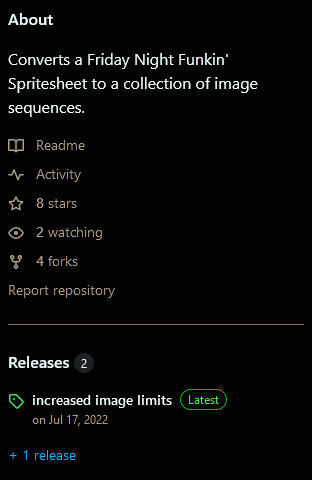

Now, once you have your programs, you'll want to download the FNF mod you want to rip the sprites from, like for instance; VS Sonic.EXE, or basically any other FNF Mod and download that either from GameBanana or GameJolt, depending on where it is.
2. Ripping the Sprites
Okay, now, to make the GIF, you have to rip the sprites. To do this, go to your FNF Mod that you downloaded and go to either mods\images\characters or assets\shared\images\characters. It depends where all the [charactername].xml and [charactername].png files of that character is located so you might have to do some digging around in the mod files. But once you find those, you want to copy & paste them into a separate folder, I recommend creating one to store all your ripped sprites at, aswell as your gifs.
3. Making the GIFs
Okay, now that you have your sprites ripped from the mod files. You'll want to open SprToPNG.bat or SprToPNG.jar. It doesn't really matter what you choose to open. It should show a small window that says “Select XML or PNG Files to Open” and you'll want to locate the files you ripped from the mod files. Please keep in mind that the .png and .xml files of that character must be in the same folder together otherwise it won't work. Just double-click on either file, again, it doesn't matter. Then, SprToPng will do the rest and separate the animation sprites into one folder that is named after that character, aswell as all the sprites.
Now, click on the folder of the sprites that you want to animate, it might say "Idle Dance" or any of the character poses, aswell as the special animations if the character has them. There should be some PNGs that are ranging from 0000 to random, depending on how many animation sprites that animation has.

Now, open EZGIF.com and click on "GIF Maker" and then click on Browse and then locate the separate PNG files of the character. A good tip is that you can select the first PNG with 0000 and then the last by shift-clicking, just click the first png and then the last one with shift-click and it'll select all the following PNG files and then select "Open". It might take a couple of seconds, depending on the file but it should show all the PNG Sprites in order.


Set the delay time to either 4, 5, or 6. You want it to act like how the actual in-game sprites would. If it's too fast, increase the delay time, if its too slow, decrease the delay time. Optionally, you can set the last PNG to 30, then select "Don't Stack Frames" so the sprites don't overlap over each other and make it look ugly.

I'll show two examples, one with "Don't Stack Frames" on and off.


On the left is with it on while on the right is with it off. You see how on the right the sprites are behind the ones that are displayed? Yeah, you don't want that. So I highly encourage and recommend you to turn on "Don't Stack Frames" on.
Now, select "Crop" and then scroll down and select "Trim Transparent Pixels around the image" as this will remove any transparent pixels we don't want, while also reducing the file size, either a tad bit or a lot, depending on the sprite.


And once you're done, click save, your sprite should look like this!

Now that you made your Sprite, you can upload it to the Funkipedia wiki to help out with pages and such that need sprites.
Fin.
Feel free to leave any suggestions in reblogs or comments, they'll really help out. Also, make sure to reblog this so more people know how to make GIFs in the future (on desktop or laptop).
4 notes
·
View notes
Text
Step-by-Step Guide to Coding for Beginners
Coding is a valuable skill in today's digital world, and it's never too late to start learning. Whether you're looking to switch careers, build websites, or create apps, coding is a great place to start. This guide will help you get started on your coding journey, covering the basics of coding and providing a roadmap for further learning.

What is coding, and why is it important?
Coding is the process of writing instructions for computers to follow. It's the language that computers use to communicate with each other and with humans. Coding is important because it's a fundamental part of the technology that drives our daily lives. From websites and apps to software and automation, coding plays a crucial role in nearly every aspect of our digital world.
What do you need to get started?
To start coding, you'll need a few things: a computer, an internet connection, and a text editor. A text editor is a program that allows you to write and save code. There are many free text editors available, including Sublime Text, Visual Studio Code, and Notepad++.
Once you have your tools set up, it's time to start learning!
Getting started with coding
The first step in your coding journey is to learn a programming language and learn what are do's and don'ts of coding. There are many programming languages to choose from, but some of the most popular and widely used include HTML, CSS, JavaScript, Python, and Java. HTML (HyperText Markup Language) is used to create the structure of websites. CSS (Cascading Style Sheets) is used to add styling and design to HTML pages. JavaScript is used to create interactive elements on websites. Python is a versatile programming language that can be used for a wide range of tasks, from data analysis to machine learning. Java is a popular language for developing Android apps and building enterprise-level applications.
Once you have chosen a programming language, it's time to start learning! There are many resources available to help you get started, including online courses, books, and tutorials. Some popular resources for learning HTML, CSS, and JavaScript include Aspire Coding, Codecademy, W3Schools, and Udemy. For learning Python, try Codecademy, Udemy, or Coursera. And for learning Java, check out Udemy, Coursera, or Oracle's Java tutorials.
Practice, practice, practice
The best way to learn coding for beginners is by doing. As you learn the basics of your chosen programming language, start experimenting with small projects. Try creating a simple website, building a calculator app, or writing a program to automate a task. The more you practice, the better you'll get, and you'll soon find that coding becomes second nature.
Take your learning to the next level
Once you have a solid understanding of the basics, it's time to take your learning to the next level. Consider taking an online course or enrolling in a bootcamp to learn more advanced concepts and skills. You can also participate in coding challenges and hackathons to put your skills to the test and learn from other coders.
Final thoughts
Coding is a valuable skill that can open up a world of opportunities. Whether you're looking to switch careers, build websites, or create apps, coding is a great place to start. With this guide and the resources available, you'll be well on your way to becoming a coding pro. Remember to practice regularly, take advantage of online resources, and never stop learning!
14 notes
·
View notes
Text
Mastering Java: Your Path to Expertise at K-Tech Infotech
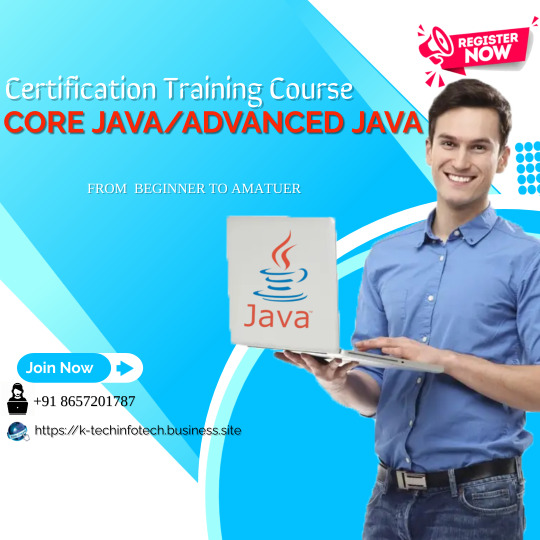
In the realm of programming languages, Java Course stands tall as a cornerstone of software development. Its versatility, reliability, and widespread use across industries make it a must-know for aspiring developers and seasoned professionals alike. At K-Tech Infotech, we’re excited to launch our comprehensive Java Course, designed to equip you with the skills and knowledge needed to thrive in the ever-evolving tech landscape.
Unveiling Our Java Course
Our Java Course isn’t just another tutorial series; it’s a holistic learning experience meticulously crafted to cater to beginners and advanced learners. Here’s a glimpse of what makes our course stand out:
1. Structured Curriculum
Foundations of Java: Dive into the basics, from syntax and data types to object-oriented programming principles.
Advanced Concepts: Explore multithreading, collections, generics, and more, delving into the intricacies of Java development.
Project-Based Learning: Apply your knowledge through hands-on projects, solidifying your skills and boosting your portfolio.
2. Expert Guidance
Our instructors are industry experts with a passion for teaching. Benefit from their wealth of experience as they guide you through complex concepts, offer practical insights, and mentor you every step of the way.
3. Flexibility and Support
We understand the importance of flexibility in learning. Our course is designed to fit into your schedule, with on-demand lessons and resources. Moreover, our support team is always available to assist you, ensuring a smooth learning journey.
4. Real-world Applications
Java isn’t just about theory; it’s about building real applications. Our course emphasizes practical application, empowering you to develop solutions that mirror real-world scenarios.
Why Learn Java with Us?
Industry Relevance: Java remains in high demand across various sectors, ensuring ample career opportunities.
Career Growth: Mastering Java opens doors to roles in software development, mobile app creation, web development, and more.
Community Engagement: Join a vibrant community of learners, collaborate on projects, and stay updated with the latest industry trends.
Ready to Embark on Your Java Journey?
Whether you’re an aspiring developer or a professional seeking to expand your skill set, our Java Course at K-Tech Infotech is the launchpad you need. Take the first step towards mastering Java Courseand unlock a world of opportunities in the tech sphere.
Enroll today and step into the exciting realm of Java Course development with K-Tech Infotech!
To learn more or enroll in our Java Course, visit https://k-techinfotech.business.site
Stay tuned for more updates, insights, and tech expertise here at K-Tech Infotech!
2 notes
·
View notes
Text
Ijen Tours (shared) from Banyuwangi
summary
Ijen Tours (shared) is the most affordable budget option to visit Ijen Crater. With the same features as the private tour, you’ll have the best experience with a lower cost. The differences you will travel in a big group combining several groups from other countries. They choose this tour because its budget friendly, and gives you an opportunity to meet new travel buddies from Indonesia and other countries while visiting Ijen.
ITINERARY
Departure (12.30 AM)
Starting the tour from your requested pick up location around Banyuwangi, and transfer to Ijen’s base camp named Paltuding. Upon arrival, take a coffee break and make preparation for ijen excursion.
Hiking to Ijen Volcano (02.00 AM)
Lead by local tour guide, you will start the journey from Paltuding at altitude 1800M ASL, hiking up through sandy tracks for about 3,5km within around 500 meters elevation gap for base camp to summit.
Ijen Blue fire (04.00 AM)
Reach the summit after 1-2 hours of trekking, you will have a chance to observe the infamous Ijen’s Blue fire. To get a better sight of blue fire, you need to walk down the crater’s rim to reach the bottom of the crater’s pit. Although the path its still on basic condition (rocky slope), visitors still willing to take risk to get a better chance observing the blue fire. Thus you need to take an extra care to reach this site.
Ijen sunrise and volcanic lake at summit
After observing the blue fire, we wont take you back to base camp directly. We would offer you to take an extra trip to reach the summit. Catch your time to get best view of the very first sunrise at Java island. After dawn, take your time at summit, enjoying the mesmerizing view of Ijen and surroundings. On top of that, you can also enjoy the view of the world’s largest acidic lake, lies at the bottom of the crater, filled with a glowing turquoise colored water, and circled by staggering crater’s barrier.
Ending the Journey
Right after you feel enough with the stunning view of Ijen, you’re going to be led back to the base camp to get back to the car. While walking, you’ll see a very beautiful view of mountains around ijen. Soon after we arrive at the base camp, we are going to drive back to the city and take you to the place where you stayed.
Package inclusion
– Tax & service
– Transportation
– English speaking driver
– English speaking guide (Ijen trekking)
– Entrance fee ticket to Ijen crater
– Gas masks & headlamps (for trekking in Ijen)
Important things that you must read before you book the tour:
– This is a shared tour/activity. So, you’ll be in a group with other travellers
– Not recommended for travelers with back problems
– Not recommended for pregnant travelers
– No heart problems or other serious medical conditions
– Average temp is going to be around 15o C
– Your insurance for this tour is on your own responsibility.
The things that you should bring during the trip:
– a pair of a good walk-able shoes; trekking shoes, running shoes, hiking shoes
– Warm clothes (long pants, scarf, jacket, some type of hoody)
– a raincoat and wet tissues (you can buy during our stops at gas stations or minimart)
– a cap or a hat
– a small backpack to carry items up the volcano
– a personal ID card (or copy)
More Tour: Ijen Private Tour From Banyuwangi
2 notes
·
View notes